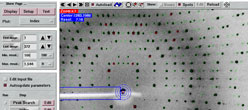5. How to Integrate and to Scale
5.1 Integration
While ipmosflm, denzo and xds are full featured data processing programs that include spot search and indexing steps, automar replaces their built-in spot search and indexing step completely by programs marPeaks and marIndex that work as a common gateway for data integration.
5.1.1 marProcess
Data processing with marProcess doesn't really require further input. For a more thorough understanding, refer to the program reference.
5.1.2 ipmosflm
The orientation angles as produced by marIndex are not used directly for running ipmosflm. Instead, marIndex writes the crystal orientation parameters in matrix form into file index.UMAT. During integration, refinement of orientation angles yields missetting angles which only describe the deviation of the orientation of the current image from the original orientation. In the "Setup"-page therefore, the field "Orientation angles" is replaced by "Missetting angles" when working with ipmosflm.
5.1.3 denzo
The orientation angles as produced by marIndex are compatible with those required by denzo the only difference being a sign change for the second angle.
When doing the integration, the only things that require special attention are reasonable choices for the integration box sizes and the crystal mosaicity. The integration box sizes can be estimated by looking at strong spots on the image and measuring their size in x and y direction. The sizes should be entered in the "Spot shape in x,y" and "BKG shape in x,y"-fields, where the latter one should typically be 0.1 to 0.2 mm larger than the spot size. The total size of the integration box must be at least two times the size of the BKG box size plus some 0.5 to 1.0 mm extra room for the estimation of the background. The log file of program denzo needs to be analyzed later if the choices were good or not. Please refer to the documentation of denzo for further understanding.
Note, that program marIndex calculates an average spot size from the spot list as generated by program marPeaks. This spot size is used to automatically update the fields for Spot shape, BKG shape and Box size. By default, the BKG shape will be the Spot shape increased by 10% and the Box size will be calculated as 2*(Spot shape + 30%). As an additional help, it is useful to only edit the Spot shape parameters manually. When hitting the RETURN key while being in the text field, the program automatically updates the corresponding entry for BKG shape and Box size! When hitting RETURN while being in the BKG shape field only the Box size entry is modified.
It is generally also a good idea, to process the data twice. The orientation matrix resulting from the indexing is based on relatively few reflections. If the crystal didn't slip in the course of the data collection, the postrefinement in scalepack is very likely to produce better missetting angles. Program scalepack will also come up with better suggestions for the actual crystal mosaicity. In particular, if the refined mosaicity is larger than the one that has been used during integration, redoing the integration is mandatory. Program automar will advise the user to do so. More than 2 cycles should normally not further improve the results.
For further understanding, please read the manuals of denzo.
5.1.4 XDS
The orientation angles as produced by marIndex are not used directly for running XDS. Instead, marIndex writes the crystal orientation parameters in matrix form into file XPARM.XDS.
Usually, the defaults for XDS will just work fine. If you want to modify the values, you should consult the XDS manual to learn about the detailed program functions.
5.2 Scaling
5.2.1 marScale
To learn more about program marScale, please refer to the actual program reference.
5.2.2 aimless
aimless is the very powerful program from the CCP4-suite of programs. It understands dozens of options. As for program ipmosflm only a selection of keywords can be controlled via the automar-GUI. There should be little need, though, to add any options manually. aimless always requires mtz-files as input. Program automar offers possibilities to feed the data integration output from marProcess and scalepack into program aimless.
5.2.3 scalepack
If you don't want or need to scale data from several crystals and/or data processing runs, you may leave the "Use multiple files"-field in the "Scale"-page unselected. In that case, the latest *.x-files in the current working directory will be used for scaling and the The "First image"-field and "Last image"-field in the main window control the data range to be scaled.
For scaling with scalepack program automar relies on program scerror for determining the correct errors (sigmas) of the integrated reflections. Program scerror has been written and is being maintained by Dr. Victor Lamzin of the EMBL-outstation at DESY, Hamburg. This program is normally operated in a cyclical way. Program scerror analyzes the output of scalepack and provides an optimized error model. The final goal is to get all Chi-squares close to 1. Only then the sigmas may be considered to correspond to some physical truth. The recommended way of doing the scaling is to run a number of cycles, e.g. 10, of scalepack and scerror without rejecting any hkl. By then, scerror may already have converged in which case the adjustment cycles will automatically stop. So it wouldn't hurt to give a much larger number of cycles. Only then some more cycles may be run with rejections turned on - up to convergence. This approach works better if the number of resolution shells is not too small (press the Default button on Resol. shells for a reasonable value. Note, that when changing the number of resolution shells a previous run of scerror becomes invalid!
When using multiple data sets, the file names entered in the "File name"-fields may be given with a path name (absolute or relative to the working directory).
For further understanding, please read the manual of scalepack.
5.2.4 XSCALE
To learn more about program XSCALE, please refer to the actual program reference.





